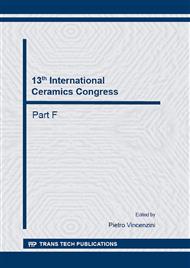[1]
P. Berdahl, H. Akbari, R. Levinson, W. Miller, Weathering of roofing materials – An overview, Constr. Build. Mater. 22 (2008) 423–433.
DOI: 10.1016/j.conbuildmat.2006.10.015
Google Scholar
[2]
M. Radeka, S. Markov , E. Loncar, O. Rudic, S. Vucetic , J. Ranogajec, Photocatalytic effects of TiO2 mesoporous coating immobilized on clay roofing tiles, J. Eur. Ceram. Soc. 34 (2014) 127–136.
DOI: 10.1016/j.jeurceramsoc.2013.07.010
Google Scholar
[3]
K. Guan, Relationship between photocatalytic activity, hydrophilicity and self - cleaning effect of TiO2/SiO2 films, Surf. Coat. Technol. 191 (2005) 155–160.
DOI: 10.1016/j.surfcoat.2004.02.022
Google Scholar
[4]
M. Diamanti, M. Ormellese, M. Pedeferri, Characterization of photo-catalytic and superhydrophilic properties of mortars containing titanium dioxide, Cement Concrete Res. 38 (2008) 1349–1353.
DOI: 10.1016/j.cemconres.2008.07.003
Google Scholar
[5]
F. Sanchez, K. Sobolov, Nanotechnology in concrete – a review, Constr. Build. Mater. 24 (2010) 2060–(2071).
Google Scholar
[6]
ISO 22197-3, 2011, Fine Ceramics, Advanced Technical Ceramics – Test Method for Air - Purification Performance of Semiconducting Photocatalytic Materials, Part 3: Removal of Toluene, International Organization for Standards.
DOI: 10.3403/30377037
Google Scholar
[7]
ISO 22197-1, 2007, Fine Ceramics, Advanced Technical Ceramics – Test Method for Air - Purification Performance of Semiconducting Photocatalytic Materials – Part 1: Removal of Nitric Oxide, International Organization for Standards.
DOI: 10.3403/30323591
Google Scholar
[8]
ISO27448, 2009, Fine Ceramics, Advanced Technical Ceramics – Test Method for Self - Cleaning Performance of Semiconducting Photocatalytic Materials – Measurement of Water Contact Angle, International Organization for Standards.
DOI: 10.3403/30200761u
Google Scholar
[9]
T. Vulic, M. Hadnadjev-Kostic, O. Rudic, M. Radeka, R. Marinkovic-Neducin, J. Ranogajec: Improvement of cement-based mortars by application of photocatalytic active Ti–Zn–Al nanocomposites, Cement Concrete Comp. 36 (2013) 121–127.
DOI: 10.1016/j.cemconcomp.2012.07.005
Google Scholar
[10]
Information on www. heromat. com.
Google Scholar
[11]
D.M. Tobaldi, R.C. Pullar, A. Sever Škapin, M.P. Seabra, J.A. Labrincha, Visible light activated photocatalytic behaviour of rare earth modified commercial TiO2, Mater. Res. Bull. 50 (2014) 183–190.
DOI: 10.1016/j.materresbull.2013.10.033
Google Scholar
[12]
B. Bhushan, Y. C. Jung, Natural and biomimetic artificial surfaces for superhydrophobicity, self-cleaning, low adhesion, and drag reduction. Prog. Mater. Sci. 56 (2011) 1–108.
DOI: 10.1016/j.pmatsci.2010.04.003
Google Scholar
[13]
O. Rudic, J. Ranogajec, T. Vulic, S. Vucetic, D. Cjepa, D. Lazar, Photo-induced properties of TiO2/ZnAl layered double hydroxide coating onto porous mineral substrates, Ceramics International, Available online 13 February 2014, http: /dx. doi. org/10. 1016/j. ceramint. 2014. 02. 017.
DOI: 10.1016/j.ceramint.2014.02.017
Google Scholar
[14]
SIST EN ISO 12572: 2002, Hygrothermal performance of building materials and products - Determination of water vapor transmission properties.
Google Scholar


